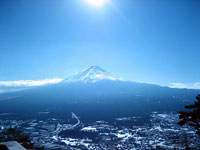Travelguide
Mt. Fuji history and useful guide
Mt. Fuji guide

Temperature -18 To +8
The region around Mt Fuji Has been the inspiration for the works of many of Japan's most celebrated writer, Poets and Artist. Sweeping up from pacific to form a nearly perfect symmetrical cone 3,776m(12,388 Ft) above the sea level. The elegant shaped Fuji-san watches over Japan,Fuji's last eruption in 1707 covered Edo(Tokyo) Some 100 Km away, with ash. Like many natural monuments held to be sacred and imbued with living spirit, Now, Mt Fuji is mountain appeared the present form about 10,000 years ago, Although, climber are known to set out to challenge the mountain through out the year, The official climbing season for Fuji-san begins on 1 July and end of 31 August. The mountain hut and service found along the trail to FujiA?es peaks are open only then. If you want to see the rising sun from Fuji's peak, start in the afternoon, stay overnight at one of the cabins near the top, and makes the remaining climb while the sky still dark, The other option is to climb through the night, the trail are well traveled and are hard to miss, Especially as thereA?ell be a continual line of people on the trail.
Fuji go-ko (Fuji Five Lakes) skirts the northern base of Fuji-san as year-round resort.
From east to west , the lakes are Yamanaka Kawaguchi Sai Shoji and Motosu. A-ko added to the end of these name signifies 'LAKE' Yamanaka-ko, which is the largest lake in the group, and the picturesque Kawaguchi-ko are the most frequented of five, but some of the best spots are hidden near the smaller and more secluded Motosu-ko Shoji-ko Sai-ko. Some recommended visits include the Narusawa Ice cave and Fugaku wind Cave , both formed by the volcanic activities of one of FujiA?es early eruption.
What is highest mountain in Japan?
It is the famous Mt Fuji which is 3,776 m high. It cannot no way be compared with the other highest peak like Mt Everest in term height. However it has become emblematic of Japan with the striking beauty of its nearly perfect conical profile and wide-flowing skirts. At the peak of dormant volcano, there is a crater, 800m across and 200m deep. From ancient time, Mt Fuji has been an object of worship as a sacred mountain. Many renowned artists have challenged to depict Mt Fuji , Among then Katsushika Hokusai, an Ukiyo-e woodblock print artist in the Edo period , painted Mt Fuji from various perspective ,at various hour of the day, in each season.
When is Mt Fuji likely to erupt?
The first record eruption of Mt Fuji was in 781, and it is said to have erupted 13 times roughly once every year till 1083. An interval of 428 years elapsed before the 14th eruption, and only 3 eruption were recorded between 1511 and 1707. Since then , no volcanic activities have been observed , which means Mt Fuji has been in a dormant state, however, there is possibility of an eruption , no matter how slim.As is the case with earthquake, it is difficult to predict volcanic eruption. But JapanA?es excellent observation system , equal to that of Hawaii, boasts of its quick response to volcanic activities making it possible to quick issue warnings.
How many volcanoes are there in Japan?
There are about 80 active volcanoes. It is said that about 10% of the 800 world's active volcanoes are concentrated in Japan. Seven volcanic belt run across the country, each of which has several active volcanoes. One of the recent major eruption \s was that of Mt Fugen in Shimabara, Nagasaki Pre. This volcano erupted in 1990 for the first time in 200 years. Its pyroclastic flow killed 43 people and lava discharged from crater covered part of Shimabara city.Many people forced to evacuate from their home.
History of Mt Fuji
The volcano we currently know as Mt Fuji formed over hundreds of southern years ago in a process that can be divided into three distinct phases of volcanic activity.
Komitake Fuji period.
700,00 to 200,000 years ago, at the time of Beijing man (Homo erects Pekinenses) And when Japan climate passing in and out of glacial and inter glacial periods, Japan was undergoing an active volcanic period. The Komitake Volcano, the [base] on which Mt Fuji later developed, is believed to have been formed during this period. by an accumulation of hardened lava and volcanic ash that eventually reached 2,500m in height. The Ashitake volcano was also erupting to south at the same time.For the tens of thousand years between the end of Komitake Fuji period and the later Old Fuji period Komitake was expose to the elements and underwent significant erosion . today , a part of Komitake crater wall can be seen at Izumi-Ga-Take near Mt Fuji 5th station.
Old Fuji period (80,000 to 16,000 years ago)
The eruption that would form the old Fuji volcano began on Komitake southern side. It is presumed form analysis of volcanic ejecta that the eruption of about 25,000 years ago. (during the Weichsel glacial period) were particularly violet. Mud and pyroclastic flow create a layer of impermeable rock , which in turn helped to bring about an abundance of spring water around the Mt Fuji. It is believe that wind carried volcanic ash from old Fuji all the way to the Kanto region. After such repeated eruption , Old Fuji reached a height oh about 2,700ms.
New Fuji period
About 10.000 years ago , eruption that would later form the new Fuji volcano broke out between the respective crater that formed old Fuji and Komitake . these eruption eventually covered the peaks of both these older volcanoes , forming the Fuji that we see today , the eruption grew less violent , and by 8,000 years ago New Fuji attained the beautiful shaped it has today.
- >> Back to Mt.Fiji
